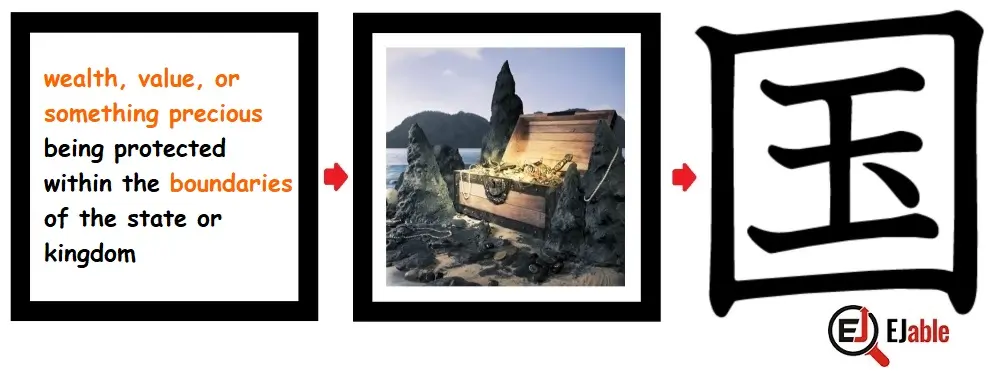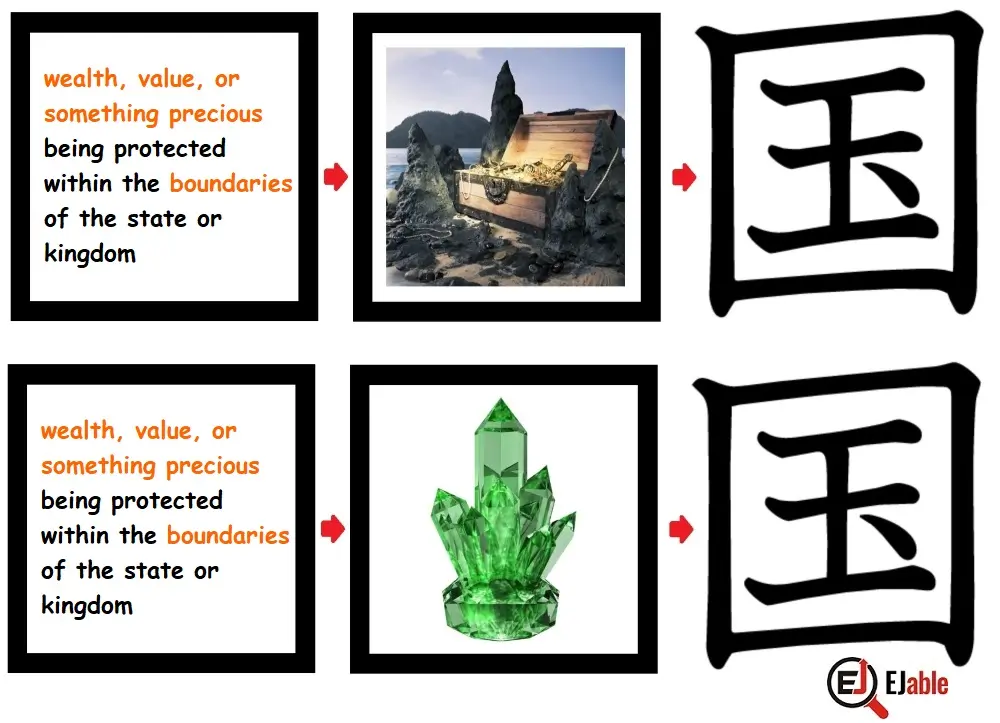Kanji for Country: 国 (Kuni, Koku)

国 is the Kanji for “country” in Japanese.
The pronunciation of the Kanji 国 is “kuni” (くに) in its kun’yomi (Japanese reading) and “koku” (コク) in its on’yomi (Chinese reading).
The Kanji 国 is constructed with 8 strokes. This Kanji is a part of the JLPT N5 syllabus (please check the list of JLPT N5 Kanji). In Japanese schools, this Kanji is taught in grade 2.
This is an easy-to-remember Kanji with a philosophical origin. However, before learning how the Kanji 国 relates to the concept of a country, it’s necessary to know the kanji characters for King and Jade or Jewel. This article will discuss these relations and other important aspects of Kanji 国, meaning “country.”
Construction and Origin of Shape 国
The Kanji for country 国 originated from a pictogram representing a walled city or a stronghold, signifying a bounded area or a community under a single rule.
Please note that the construction of the country’s kanji has 8 strokes and the following two parts:
- Radical for enclosure 囗
- A subcomponent of Jade’s Kanji
Over time, the character evolved to its current form, combining the elements of an enclosure (囗) and a jewel (Jade, 玉). Therefore, it symbolizes a territory or a realm under sovereign control. Please note that the Kanji of Jade resembles the Kanji for King and is closely related to it. Therefore, this subcomponent 玉 can also represent a weapon depicting control.
Note: The radical 囗 can be misinterpreted as the Kanji for mouth. However, as mentioned in our guide for the common Kanji radicals, The character 囗 represents a mouth only when it does not enclose any other character in a Kanji.
Mnemonic: How to Remember the Kanji of Country (国)
As a prerequisite to understanding and remembering the Kanji 国, knowing the Kanji for King first and then the Kanji for Jade is necessary. Please note that Jade also represents jewels or treasure. Moreover, traditionally, this gem has been closely associated with royalty in Japan and China.
It’s very easy to remember the Kanji for the country if you focus on the fact that there is a Kanji for Jade (jewel) inside an enclosure. This simple fact beautifully explains the logic behind this Kanji pictogram representing the country. This mnemonic is illustrated in the following picture to make remembering the Kanji for the country easy.


Explanation of the Mnemonic
The inclusion of the jade (玉) radical within the Kanji for “country” (国) is a fascinating aspect of its evolution.
The original form of 国 depicted a walled city or a stronghold, symbolizing a bounded area. Incorporating of 玉 (jade) within this enclosure could be interpreted as a symbol of wealth, value, or something precious being protected within the boundaries of the state or kingdom.
Jade was highly valued in ancient East Asian cultures, often associated with power and status. Thus, its presence in the Kanji for the country could signify a nation’s richness or valuable core, both in terms of material wealth and cultural significance.
Does 国 Only Mean “Country”?
As for other meanings, 国 primarily means “country” or “nation”. However, in historical texts, 国 may refer to provinces or regions within Japan. It was when the country was divided into smaller, semi-autonomous areas. The concept of a bounded area or a domain governed by a ruler is central to its various uses.
Country (Koku) Kanji in Compounded Words
The Kanji for country commonly appears in many compounded Kanji characters. There are 604 Japanese words that begin with the Kanji 国, and it appears in 1358 words.
Examples of Kanji 国 in Compounded Kanji Characters
Following are the examples where Kanji for power or strength appears in Japanese compounded Kanji characters:
- 国家 (こっか / kokka): Nation, state.
- 国民 (こくみん / kokumin): Citizens, nationals.
- 国語 (こくご / kokugo): National language.
- 国境 (こっきょう / kokkyō): National border.
- 国際 (こくさい / kokusai): International.
- 外国 (がいこく / gaikoku): Foreign country.
- 国王 (こくおう / kokuō): King, monarch.
- 母国 (ぼこく / bokoku): Motherland, homeland.
- 国立 (こくりつ / kokuritsu): National, state-run.
- 国会 (こっかい / kokkai): National Diet, parliament.
- 同国 (どうこく / dōkoku): The same country.
- 国内 (こくない / kokunai): Domestic, within the country.
- 帰国 (きこく / kikoku): Return to one’s country.
- 国宝 (こくほう / kokuhō): National treasure.
- 国旗 (こっき / kokki): National flag.
Traditional Kanji for Country
While 国 is the Japanese Kanji meaning country, 國 is the traditional Kanji representing “country”.
國 is the traditional or classical form of the Kanji, while 国 is the simplified form. The simplification of Kanji characters occurred in the mid-20th century as part of language reforms in Japan, where more complex characters were simplified to make them easier to write and learn.
The traditional form of the Kanji 國 for “country” is used primarily in Taiwan, where traditional Chinese characters are the standard. However, it’s not exclusively used in Taiwan. This character is also seen in other contexts:
- Hong Kong and Macau: These regions also use traditional Chinese characters, including 國.
- Classical and Historical Texts: In Japan and regions that have transitioned to simplified characters, 國 may still be found in classical literature, historical documents, and various contexts where traditional forms are preserved.
- Overseas Chinese Communities: Some overseas Chinese communities, particularly those with historical ties to Taiwan or other regions using traditional characters, might also use 國.
- Cultural and Artistic Usage: In artistic, calligraphic, and certain cultural contexts, the traditional form might be preferred for its aesthetic value.
Therefore, while 國 is most commonly used in Taiwan, its usage extends to other regions and contexts where traditional Chinese characters are employed or valued.
Check other Kanji characters on the page “How to Remember Kanji“.


A long-term ex-pat in Japan, Himanshu comes with an IT background in SAP consulting, IT Business Development, and then running the country operations of an IT consulting multinational. Himanshu is the co-founder and Managing Director of ReachExt K.K. and EJable.com. He is also an Advisory Board Member of a Silicon Valley AI/IoT startup.

